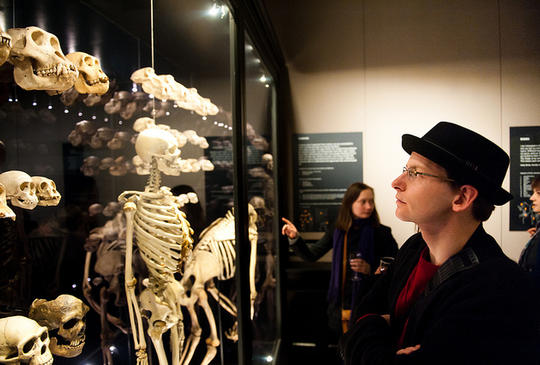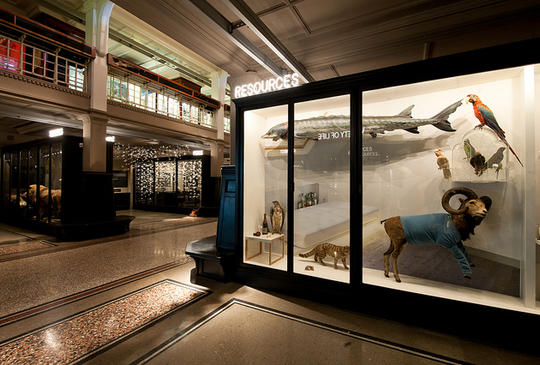
From natural history to environmental sustainability
-
Way back in 1868, Thomas Huxley – famous biologist and liberal thinker – advised Owens College (now the University of Manchester) that it should take on the running of a large natural history collection that had been formed by wealthy Manchester businessmen and intellectuals. The college rose to the challenge and the collection was transferred to the present purpose-built museum on Oxford Road, opening in 1888.
Since then, the Manchester Museum has attracted millions of visitors, mostly from the local area. It is Manchester’s ‘traditional’ museum, with mummies, stuffed animals, ancient pots and fossils. It is also part of the University of Manchester and is in fact the biggest university museum in the UK. These features make the museum an especially interesting location to present and discuss ideas, particularly around sustainability.
Like other universities, the University of Manchester undertakes student teaching and research, but one aspect of its work that is developing into a particularly distinctive feature of the University of Manchester is its strong, clearly visible commitment to social responsibility. The Museum has a particular role in delivering social responsibility activities for the University, delivered through exhibitions, public events and educational sessions for school pupils.
Our work draws on the collections and on our position as a university museum with a strong social responsibility emphasis, and fits into two broad strands: promoting understanding between cultures (both today and from the past) and working towards a sustainable world. These two strands of activity give us both a direction and a destination, and are very helpful in articulating the Museum and its aims to visitors, stakeholders and staff.
Making a difference
Manchester Museum isn’t an ancient monument, to be preserved in perpetuity (well, the building is listed) – it is a working building. This presents some particular challenges, and opportunities, when it comes to redeveloping exhibitions and galleries.
In 2008, an opportunity arose to redevelop the old Mammal Gallery, part of the original Waterhouse museum (but redeveloped several times since first opening). We had wanted to do this for some time as the gallery had fallen badly out of date. The architecture was great (if sometimes hidden by 20th century accretions), the specimens were great, but the interpretation and ordering principles no longer reflected our aims and aspirations.
For some time, we had been rethinking how we wanted to work with visitors and what difference we wanted to make, both to visitors’ lives and to the world beyond the Museum. So, we thought about what the ‘natural history’ topics should be for a 21st century university museum and, just as importantly, what we intended to achieve by the project. The answer came quite quickly, as we had a gut feeling about it. If 19th century natural history had been dominated by the need to classify the world as it was opened up to science and commercial exploitation, and the 20th was dominated by the discovery that people were having negative impacts on the planet, then surely the 21st has to be about moving beyond that ‘phase’ and seeking to work towards environmental sustainability.

Do something great
A significant element of the funding came from the North West Development Agency; this was a great funding stream as they just said ‘do something great’. This allowed us to think boldly and creatively, and to emphasise innovation aspects of our project, a level of freedom that doesn’t always come with funding. So, we took the bull by the horns and thought, if we are going to make this as great as it can be, what can we do and what do we need to bring in. We knew that we wanted to connect with visitors, connecting with their own lives rather than just far-distant places, so we engaged designers who were great at what we can’t do: build strong emotional engagement. We employed villa eugenié, a fashion-events designer based in Brussels, to work with us on the development of the gallery, ‘Living Worlds’, which opened in April 2011.
‘Living Worlds’ is different to other natural history galleries. In fact, it isn’t really a natural history gallery at all. Natural history ‘makes’ nature historical: it turns nature into an understood, described narrative. I’d argue that that view is not particularly helpful when trying to engage people in a sustained way with nature. To my mind, nature isn’t a learn-by-rote schoolbook lesson, like the Kings and Queens of England. It is where we are, where we live, where we came from, what we use, what we are connected to, the past, present and future. The learn-by-rote view of nature is, if anything, partly responsible for disengagement from nature: once people have learnt enough of the outline of natural diversity, they are left with little else to do: they’ve ‘done’ nature.
The learn-by-rote view of nature is, if anything, partly responsible for disengagement from nature: once people have learnt enough of the outline of natural diversity, they are left with little else to do: they’ve ‘done’ nature.
‘Living Words’ tries to do something quite different, so that rather than simply restating environmental ‘problems’ (as often happens), it tries to do something about them. It achieves this be encouraging visitors to think about their attitudes and values about nature in an open-ended and non-judgmental way. This is a way of opening a dialogue, and engaging people with nature through a connection to them from their own position. The gallery and the project is certainly not a cynical attempt to manipulate people to do things they don’t want to: far from it, it is about finding ways for people to connect with their natural environment in ways that are meaningful and positive for them (just as we are not so cynical as to believe that the great majority people don’t care about the world around them).
Typologies and attitudes to nature
Three pieces of work were very important to us in the development of the gallery. The first was a piece of work by American sociologist and environmentalist Stephen Kellert. From the late 1970s, he developed a typology of attitudes to nature among members of the public. Each of us has a profile made up of how strongly we reflect each of a number of different attitudes to nature: nature as experience, concern for the treatment of animals, fear of nature, interest in the internal working of animals’ bodies, in the connections between living things as a system, as raw materials to use, as beauty and symbol, and so on. We used knowledge of this to map different attitude types onto a range of themes exploring the human-nature spectrum, some more human-focused, some more ‘nature’-focused. This meant that we would be able to connect meaningfully with a greater segment of our visitors than a gallery that ‘explored scientific things, in scientific ways, for scientific people’.
Telling people depressing stories about enormous problems in far-away places is not just problematic, it is actually demotivating – it is worse than doing nothing.
The second piece of work was a piece of work produced by London-based environmental-communications firm Futerra, ‘Branding Biodiversity’. They argue persuasively, and other work backs this up, that telling people depressing stories about enormous problems in far-away places is not just problematic, it is actually demotivating – it is worse than doing nothing. In fact the problem is often not that people don’t know about environmental ‘issues’ (and wouldn’t it be nice to be able to stop thinking about the environment as a series of issues), it is that they are often either disempowered from doing anything about them, or they don’t know what they can do to address them. We worked with knowledge of this so that, if we were presenting difficult topics, they were matched with information on things that people could do about them. Just as importantly, we think it is important that people are congratulated for the things that they already do themselves, and encourage them to think about what else they might be interested in taking up, should they want to.
The third piece of work was the New Economics Foundation’s (NEF) ‘five ways to well-being’: connect, be active, take notice, keep learning and give. This helped us to develop a way to ‘sell’ nature to visitors, so that the strapline became ‘whether you value nature for its own sake or because it can make you feel good, nature has so much to offer’.
Taken together, the Kellert, Futerra and NEF pieces of work made for a really coherent ‘toolkit’ for us to interpret subjects and work with audiences as individual human beings, and to explore the natural world and people’s relationships with it.

Beyond Living Worlds
‘Living Worlds’ has been a very successful project for us, articulating who we are, what we believe in, and how we want to work with our visitors. It has been the ‘axis’ around which a number of other activities have been developed. An allotment in front of the Museum has been especially popular and we now have a beehive on the roof. The gallery has been complemented by a series of temporary exhibitions on environmental sustainability, including exhibitions about people who were tattooed with images of endangered British species to become species ambassadors, environmental and social sustainability in Ecuador, and on the relationship between people and trees in Manchester (in partnership with the British Ecological Society).
We developed a series of films of local people with a wide variety of connections to nature as the ‘Nature and Me’ project funded by the HLF; some of these films can be seen in the gallery itself. The gallery is flexible enough to be the location of a very wide range of events and stimulus for more, from day-to-day visits by the general public, themed ‘Big Saturday’ events for families, adult education courses on wildlife recording, and panel discussions with academics on environmental ethics.
In many ways, the real work only began once ‘Living Worlds’ opened: using the gallery as a tool to stimulate and galvanise public interest in environmental sustainability, turning interest and enthusiasm into active engagement, spectators into participants and activists.
This is our idea of the kind of difference we should be trying to make, as a socially responsible university museum for the 21st century.
Contributor Profile
Henry McGhie is Head of Collections and Curator of Zoology at the Manchester Museum, part of the University of Manchester. His work consists of bringing collections and ideas to lie as part of exhibitions, student teaching and public events. He is extremely passionate about the natural environment (especially birds), about museums and about the power of personal choice.

